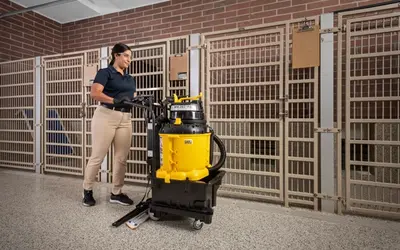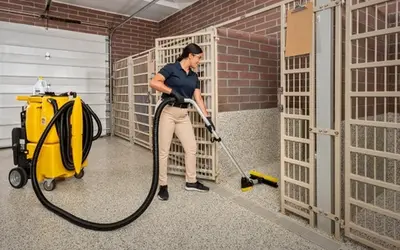How to Clean an Industrial Facility

Cleaning an industrial facility is no small feat. These buildings are large with a diversity of spaces and functions. There can be factory floors filled with equipment, soaring warehouses with multiple dock doors, lots of restrooms and shower facilities along with break rooms, kitchenettes and offices. They often operate 24 hours a day, making thorough cleaning even more challenging.
Maintaining these spaces can be complicated as there is no one industrial facility. Factories that churn out computer or electrical equipment are very different than those that produce food or chemicals or cars. There may be clean rooms and laboratories outfitted with sensitive equipment. Or there may be dangers as workers deal with heavy machinery, industrial lubricants, chemicals, fiberglass and metal shavings.
In all of its permeations, manufacturing remains a vital part of the U.S. economy, employing 12.0 million workers in 2013, 8.8 percent of total U.S. employment. Knowing how to clean an industrial facility helps keep this sector chugging along.
The Evolving Warehouse
David Friedman, president of Conor Commercial Real Estate points out that the modern industrial facility looks very different than those of the past. For example, floors are getting stronger to accommodate more weight. Ceilings are growing taller to fit advanced racking systems. Dock door density is also increasing to accommodate the demands of e-commerce.
Warehouses are also getting bigger, with 27% of them between 25,000 and 50,000 square feet. Thirty seven percent clock in at greater than 100,000 square feet. Amazon has fulfillment centers that cover one million square feet and more.
That’s a lot of floor to maintain.
Keeping all of that square footage free of dirt and debris is critical to warehouse operations. Fuel spills, forklift tire marks, pallet chips and cardboard become slip and fall hazards. The bulk of the dirt, about 80% according to Richard Bodo, director of training for Karcher North America, is dry particulate soils. As most of that debris blows in through open doors, the trend of increasing dock door density means increased places for dirt to infiltrate.
The result can hurt business.
‘That soil…damages surfaces and creates a dirty appearance on warehouse and DC floors,’ says Bodo in an article in Modern Materials Handling. ‘No one wants to have to handle and ship products that are dirty and dusty.’
Warehouse Cleaning Simplified
Traditionally, cleaning these floors requires three steps: sweeping up debris, either by hand with a dust mop or with a direct throw or overthrow sweeping machine, scrubbing them with an expensive and complicated autoscrubber and then waiting for the floor to dry before work can resume.
Kaivac offers a better way. The easy-to-use, battery-powered AutoVac Stretch combines sweeping, scrubbing and drying. The advanced technology can:
- Eliminate the need for dust mopping
- Remove 99.8% of soils
- Clean 16,000 square feet an hour
- Be converted to pick up spills, extract grease and clean rubber comfort mats
Cleaning Locker Rooms and Restrooms
Cleaning industrial facility employee spaces pose unique challenges. The usual issues of removing dirt, microbes and germs are compounded by workers tracking debris, liquids, grease and chemicals from the factory floor into these spaces.
For an example, look to Pittards, a 200-year-old manufacturer of leather products. Located in the United Kingdom, they count Adidas, New Balance and Puma among their clients. Despite trying various cleaning methods, their worker changing rooms had become badly soiled. While the issue is common in their industry, company officials were growing concerned.
Even without the added complexity of industrial materials, cleaning restrooms and locker rooms is time-consuming and complex. Cleaning a restroom by hand can take between 45 minutes to three hours, depending on the size. Workers must stock all of the dispensers, collect trash, dust, sanitize countertops and toiles, mop the floors and wipe down walls and partitions.
Not only time consuming, this method produces limited results as dirt, grime and odor get left behind.
For better results, choose a Kaivac No-Touch Cleaning system.
The system combines an indoor pressure washer, chemical injection and wet-vacuum technology into one machine. Surfaces are left clean, fresh-smelling and dry without workers ever having to touch potential contaminates.
The machine transformed Pittards’ badly-soiled changing rooms. ‘It impressed everyone,’ says the cleaning contractor. ‘(The machine is) fast, provides great results (and is) less strenuous for our cleaning staff.’
Cleaning Offices, Break Rooms and Kitchenettes
Industrial offices, break rooms and kitchenettes need attention too. Break rooms, in particular, are one of the dirtiest places in any office. Study show that sink faucet handles, microwave and vending machine buttons and the refrigerator door harbor an alarming number of germs and soils. Germs also congregate on office keyboards, computer mice, pens, pencils and even the desk itself.
Specialized touchpoint cleaning tools can keep these areas clean and your workers healthy. The KaiFly flat surface cleaning system removes 80 times more bacteria from desktops and tabletops than standard wipes and cloths. KaiWipes and SmartTowel quickly and easily clean irregular surfaces without the risk of cross-contamination.
Knowing how to clean an industrial facility will keep workers healthy and production moving. Find out about more tools and techniques here.
Related Posts

The Best Dog Kennel Cleaning Equipment
There are ways to simplify the kennel cleaning process. Automatic kennel cleaning equipment can simplify the kennel cleaning process and can save hours of daily, back breaking labor–even for facilities without central drains.
Read more
A Better Retail Floor Care Option: How One National Retailer Reclaimed Floor Care
Discover how a national retailer cut costs and improved results by switching to Kaivac’s All Floor™ system—an easy, all-in-one floor care solution perfect for low-revenue retail locations.
Read more
The Prodigal Pooch Loses Odors, Gains Clients Thanks To No-Touch Cleaning System
The change at The Prodigal Pooch was immediate. After just two days of using No-Touch Cleaning the look, smell, and feel in the kennel rooms improved. Two weeks later the odor was completely gone.
Read more